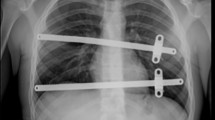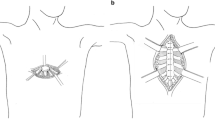Abstract
Purpose
The aim of this study was to evaluate the pleural and pericardial morbidity in patients that had undergone pectus excavatum corrections using minimal access repair of pectus excavatum (MARPE) at a single center.
Materials and methods
Data from patients after MARPE from 2000 to 2007 were prospectively collected. Patients with pneumothorax and pleural and pericardial effusions were identified.
Results
One hundred eighty patients were corrected by MARPE. Eighty-four were identified to have pleural or pericardial morbidities. Pneumothorax was documented in 33 patients and five required placement of a chest tube. Pleural effusions were recorded in 53 and were found to recur in four patients. Drainage was necessary in 18 patients. Pericardial effusions were observed in five patients; in two cases, they were associated with recurring pleural effusions, suggesting postcardiomyotomy syndrome.
Conclusions
MARPE is associated with a high rate of pleural and pericardial morbidities, but only a small number requires interventions.
Similar content being viewed by others
References
Scherer LR, Am PH, Dressel DA (1988) Surgical management of children and young adults with Marfan syndrome and pectus excavatum. J Pediatr Surg 23:1169–1172 doi:10.1016/S0022-3468(88)80335-X
Nuss D, Kelly RE Jr, Croitoru DP et al (1998) A 10-year review of a minimally invasive technique for the correction of pectus excavatum. J Pediatr Surg 33:545–552 doi:10.1016/S0022-3468(98)90314-1
Boehm RA, Muensterer OJ, Till H (2004) Comparing minimally invasive funnel chest repair versus the conventional technique: an outcome analysis in children. Plast Reconstr Surg 114:668–675 doi:10.1097/01.PRS.0000130938.87402.B0
Hebra A, Swoveland B, Egbert M et al (2000) Outcome analysis of minimally invasive repair of pectus excavatum: review of 251 cases. J Pediatr Surg 35:252–257 doi:10.1016/S0022-3468(00)90019-8
Moss RL, Albanese CT, Reynolds M (2001) Major complications after minimally invasive repair of pectus excavatum: case reports. J Pediatr Surg 36:155–158 doi:10.1053/jpsu.2001.20039
Nuss D, Croitoru DP, Kelly RE Jr et al (2002) Review and discussion of the complications of minimally invasive pectus excavatum repair. Eur J Pediatr Surg 12:230–234 doi:10.1055/s-2002-34485
Hosie S, Sitkiewicz T, Petersen C et al (2002) Minimally invasive repair of pectus excavatum—the Nuss procedure. A European multicentre experience. Eur J Pediatr Surg 12:235–238 doi:10.1055/s-2002-34486
Park HJ, Lee SY, Lee CS (2004) Complications associated with the Nuss procedure: analysis of risk factors and suggested measures for prevention of complications. J Pediatr Surg 39:391–395 doi:10.1016/j.jpedsurg.2003.11.012
Molik KA, Engum SA, Rescorla FJ et al (2001) Pectus excavatum repair: experience with standard and minimal invasive techniques. J Pediatr Surg 36:324–328 doi:10.1053/jpsu.2001.20707
Schalamon J, Pokall S, Windhaber J et al (2006) Minimally invasive correction of pectus excavatum in adult patients. J Thorac Cardiovasc Surg 132:524–529 doi:10.1016/j.jtcvs.2006.04.038
Saxena AK, Castellani C, Höllwarth ME (2007) Surgical aspects of thoracoscopy and efficacy of right thoracoscopy in minimal invasive repair of pectus excavatum. J Thorac Cardiovasc Surg 133:1201–1205 doi:10.1016/j.jtcvs.2007.01.040
Hoel TN, Rein KA, Svennevig JL (2006) A life-threatening complication of the Nuss-procedure for pectus excavatum. Ann Thorac Surg 81:370–372 doi:10.1016/j.athoracsur.2004.09.008
Leonhardt J, Kubler JF, Feiter J et al (2005) Complications of the minimally invasive repair of pectus excavatum. J Pediatr Surg 40:e7–e9 doi:10.1016/j.jpedsurg.2005.07.033
Marusch F, Gastinger I (2003) Life-threatening complication of the Nuss-procedure for funnel chest. A case Report. Zentralbl Chir 128:981–984 doi:10.1055/s-2003-44807
Castellani C, Schalamon J, Saxena AK et al (2008) Early complications of the Nuss procedure for pectus excavatum: a prospective study. Pediatr Surg Int 24(6):659–666
Engum S, Rescorla F, West K, Rousse T, Scherer LR, Grosfeld J (2000) Is the grass greener? Early results of the Nuss procedure. J Pediatr Surg 35:246–251 doi:10.1016/S0022-3468(00)90018-6
Croitoru DP, Kelly RE Jr, Goretsky MJ et al (2002) Experience and modification update for the minimally invasive Nuss technique for pectus excavatum repair in 303 patients. J Pediatr Surg 37:437–445 doi:10.1053/jpsu.2002.30851
Ong CC, Choo K, Morreau P et al (2005) The learning curve in learning the curve: a review of Nuss procedure in teenagers. ANZ J Surg 75:421–424 doi:10.1111/j.1445-2197.2005.03402.x
Ostlie DJ, Marosky JK, Spilde TL et al (2003) Evaluation of pectus bar position and osseous bone formation. J Pediatr Surg 38:953–956 doi:10.1016/S0022-3468(03)00132-5
Saxena AK, Wilital GH (1998) Surgical correction of funnel chest using titanium struts. Surg Childh Intern 6:230–232
Rosenberg A, Gratz KW, Sailer HF (1993) Should titanium miniplates be removed after bone healing is complete? Int J Oral Maxillofac Surg 22:185–188 doi:10.1016/S0901-5027(05)80249-8
Torgersen S, Gilhuus-Moe OT, Gjerdet NR (1993) Immune response to nickel and some clinical observations after stainless steel miniplate osteosynthesis. Int J Oral Maxillofac Surg 22:246–250 doi:10.1016/S0901-5027(05)80647-2
Rushing GD, Goretsky MJ, Gustin T et al (2007) When it is not an infection: metal allergy after the Nuss procedure for repair of pectus excavatum. J Pediatr Surg 42:93–97 doi:10.1016/j.jpedsurg.2006.09.056
Berberich T, Haecker FM, Kehrer B et al (2004) Postpericardiotomy syndrome after minimally invasive repair of pectus excavatum. J Pediatr Surg 39:e1–e3 doi:10.1016/j.jpedsurg.2004.07.029
Khan AH (1992) The postcardiac injury syndromes. Clin Cardiol 15:67–72
Muensterer OJ, Schenk DS, Praun M et al (2003) Postpericardiotomy syndrome after minimally invasive pectus excavatum repair unresponsive to nonsteroidal anti-inflammatory treatment. Eur J Pediatr Surg 13:206–208 doi:10.1055/s-2003-41269
Petersen C, Leonhardt J, Duderstadt M et al (2006) Minimally invasive repair of pectus excavatum—shifting the paradigm? Eur J Pediatr Surg 16:75–78 doi:10.1055/s-2006-924001
Author information
Authors and Affiliations
Corresponding author
Rights and permissions
About this article
Cite this article
Castellani, C., Saxena, A.K., Zebedin, D. et al. Pleural and pericardial morbidity after minimal access repair of pectus excavatum. Langenbecks Arch Surg 394, 717–721 (2009). https://doi.org/10.1007/s00423-008-0448-6
Received:
Accepted:
Published:
Issue Date:
DOI: https://doi.org/10.1007/s00423-008-0448-6




